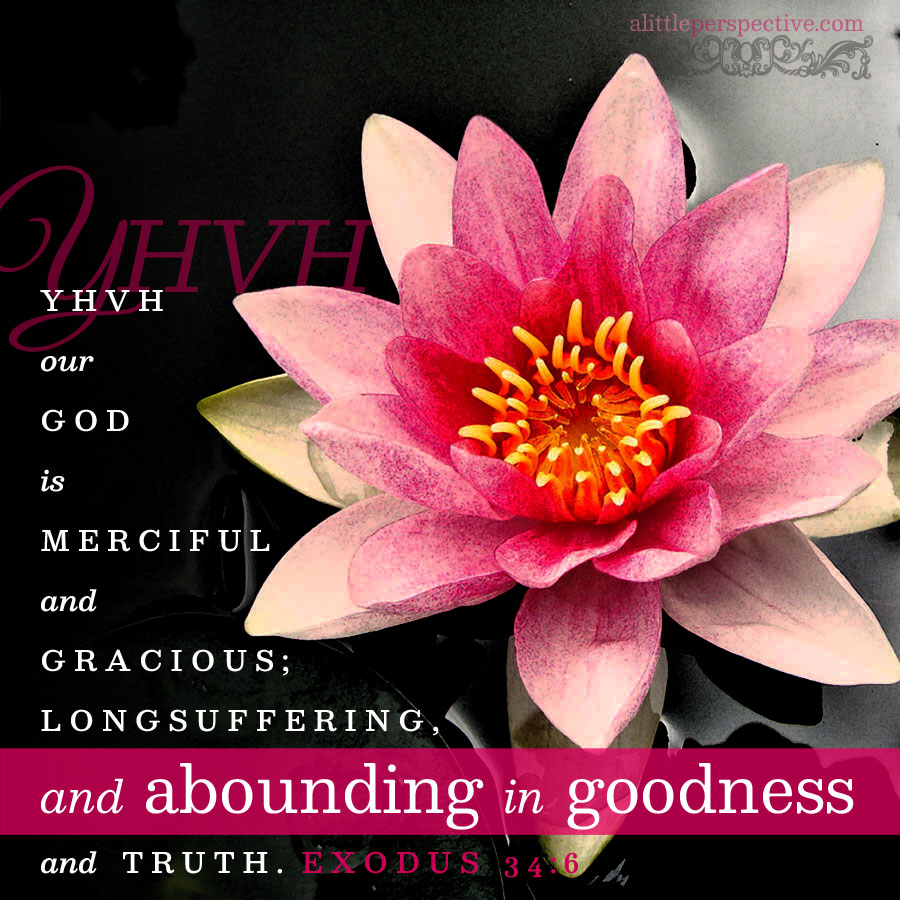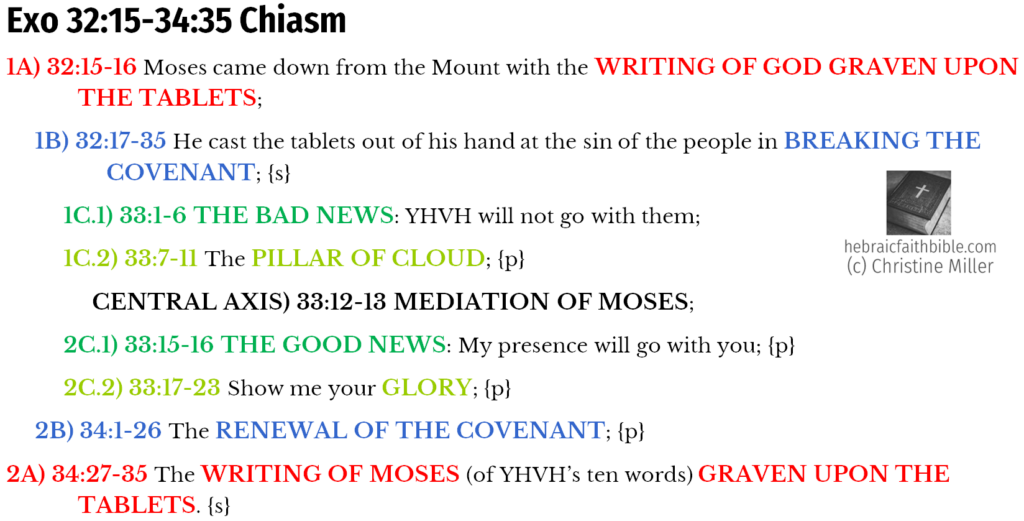Read Exodus 32:15-34:35 at Bible Gateway.
The teaching tools of scripture
Gen 1:1-2:3 and the teaching tools of scripture part one and part two
Gen 1:1-6:8 and finding the topic themes of scripture
Hebrew paragraph divisions
32:15-35 {s} Moses and the Levites restrained the sin of the people / the mediation of Moses
33:1-11 {p} The bad news: YHVH will not go up with them / Moses made his personal tent the tabernacle of meeting
33:12-16 {p} Mediation of Moses: My presence will go with you, and I will give you rest
33:17-23 {p} The plea of Moses: show me Your glory
34:1-26 {p} The renewal of the covenant, the Ten Commandments
34:27-35 {s} The 2nd set of tablets / Moses’ face shown with the glory of YHVH he had seen
Strong themes of the parashah
32:15-33:11 {s+p} Sin brings about Moses’ (Messiah by type) mediation, so that we meet with God (tabernacle) in Immanuel (Messiah’s personal tent)
Exo 32:15-34:35 Chiastic structure
Download the fully expanded Exo 32:15-34:35 Triennial Vayifen vayered Moshe chiasm pdf (Coming …).
Theme of the parashah
The commandments restrain our sin, and allows the mediation of Messiah to secure our forgiveness and the renewal of the covenant of grace.
Finding Messiah in Triennial Vayifen vayered Moshe
YHVH gives Moses the bad news, as the Scripture calls it (evil tidings), that His Presence will not go with them. This has been the bad news since the day of Adam’s fall. That I am exiled from the Presence of YHVH, that His Presence go not up with me, is the bad news. But then before we get to Moses’ intercession and the good news, Scripture interrupts our narrative with a seemingly unrelated detail, about where Moses pitched the tabernacle of meeting, and how YHVH talked with Moses face to face.
And Moses took the tabernacle, and pitched it outside the camp, afar off from the camp, and called it the Tabernacle of meeting. And it came to pass, that every one who sought YHVH went out unto the tabernacle of meeting, which was outside the camp. And it came to pass, when Moses went out unto the tabernacle, that all the people rose up, and stood every man at his tent door, and looked after Moses, until he was gone into the tabernacle. And it came to pass, as Moses entered into the tabernacle, the pillar of cloud descended, and stood at the door of the tabernacle, and YHVH talked with Moses. And all the people saw the pillar of cloud stand at the tabernacle door, and all the people rose up and worshiped, every man in his tent door. And YHVH spoke unto Moses face to face, as a man speaks unto his friend. And he turned again into the camp; but his servant Joshua, the son of Nun, a young man, did not depart out of the tabernacle. Exo 33:7-11
In fact, this is not an unrelated detail. In Hebrew, the phrase that is used here and throughout the rest of Torah, for tabernacle or tent of the congregation, is moed: the tabernacle of moed. Moed, in Hebrew, is an appointment, like an appointment on a calendar.
And YHVH spoke unto Moses, saying, “Speak unto the children of Israel, and say to them: ‘Concerning the feasts (moedim) of YHVH, which you shall proclaim to be holy convocations, even these are My feasts (moedim).” Lev 23:1-2
The festivals, or holy days, that is, holidays, of YHVH (not of the Jews) are His set times of appointment. But the vast majority of the time that moed occurs in Torah, it is as the tabernacle of moed—of meeting. From this we learn that moed is an appointed or set time, or an appointed or set place, that He has reserved in order to meet with His people. Therefore the English translation of “tabernacle of moed” is “tent of meeting” and not tent of appointment. The Hebrew reveals the purpose of the appointment, so that God may meet with man, to draw near to each other until they meet.
It is not an accident that the out of place detail about Moses pitching the tabernacle of meeting, is sandwiched between the bad news of God’s Presence separated from Israel, and the good news (“Gospel”) of “My Presence will go with you, and I will give you rest,” (Exo 33:14). The tabernacle of meeting is a prophetic picture of Messiah and the new birth, of God’s Presence dwelling with the believer through Messiah, and brings us to the good news.
This is not another example of Moses getting God to change His mind. Moses did not change God’s mind, for He is unchanging. But the way God interacted with Moses throughout this incident, He did purposely for our sakes, to paint a prophetic picture of the bad news, and the good news. And once again it is Moses’— Messiah’s—intervention that brings about the good news.
Additional readings for this parashah
Psa 64 (my notes) | 2 Sam 22 (my notes) | Rom 9 (my notes)
Studies in Triennial Vayifen vayered Moshe
Exodus 32, Bible for Beginners
Exodus 33, Bible for Beginners
Exodus 34, Bible for Beginners
Exo 30:11-34:35, Loose ends reveal the gospel
Exo 30:11-34:35, Chiasm preaches the gospel of grace from Torah
Walking in the Torah and the Spirit
Exo 31 and 32, The gospel of grace in the golden calf incident
Exo 31 and 32, Changing times and law
Exo 33 and 34, The bad news and the good news
Exo 33:12-16, My presence shall go with you
Exo 33:12-34:26, Chiastic structures of the strong themes
Exo 34:1-26, Chiastic structures of the strong theme
Exo 34:6-7, On generational curses
SCRIPTURE REVEALED SERIES by CHRISTINE MILLER:
THE LAW of LOVE | FINDING MESSIAH in TORAH | EXODUS in CHIASTIC STRUCTURE


















Leave a Reply